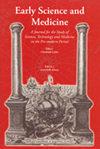Prayer and Physic in Seventeenth-Century England
IF 0.2
2区 哲学
Q3 HISTORY & PHILOSOPHY OF SCIENCE
引用次数: 0
Abstract
Historians have often represented prayer as an instrumental response to illness. We argue instead that prayer, together with physic, was part of larger regimes to preserve health and prevent disease. We focus on early modern England, through the philosophical writings of the physician, Robert Fludd, and the medical records of the clergyman, Richard Napier. Fludd depicted health as a fortress and illness as an invasion by demons; the physician counsels the patient in maintaining and restoring moral and bodily order. Napier documented actual uses of prayer. As in Fludd’s trope, through prayer, Napier and his patients enacted their aspiration for health and their commitment to a Christian order in which medicine only worked if God so willed it. Prayer, like physic, was a key part of a regime that the wise practitioner aimed to provide for his patients, and that they expected to receive from him.17世纪英国的祈祷与生理学
历史学家经常将祈祷视为对疾病的一种工具性反应。相反,我们认为祈祷和医学是保护健康和预防疾病的更大制度的一部分。我们通过医生Robert Fludd的哲学著作和牧师Richard Napier的医疗记录,关注现代早期的英格兰。弗鲁德把健康描绘成一座堡垒,把疾病描绘成恶魔的入侵;医生建议病人保持和恢复道德和身体秩序。纳皮尔记录了祈祷的实际用途。正如Fludd的比喻一样,通过祈祷,Napier和他的病人实现了他们对健康的渴望,以及他们对基督教秩序的承诺,在这个秩序中,只有上帝愿意,医学才能发挥作用。祈祷和医学一样,是一个制度的关键部分,聪明的医生旨在为他的病人提供,他们希望从他那里得到。
本文章由计算机程序翻译,如有差异,请以英文原文为准。
求助全文
约1分钟内获得全文
求助全文
来源期刊

Early Science and Medicine
HISTORY & PHILOSOPHY OF SCIENCE-
CiteScore
0.50
自引率
0.00%
发文量
22
审稿时长
>12 weeks
期刊介绍:
Early Science and Medicine (ESM) is a peer-reviewed international journal dedicated to the history of science, medicine and technology from the earliest times through to the end of the eighteenth century. The need to treat in a single journal all aspects of scientific activity and thought to the eighteenth century is due to two factors: to the continued importance of ancient sources throughout the Middle Ages and the early modern period, and to the comparably low degree of specialization and the high degree of disciplinary interdependence characterizing the period before the professionalization of science.
 求助内容:
求助内容: 应助结果提醒方式:
应助结果提醒方式:


